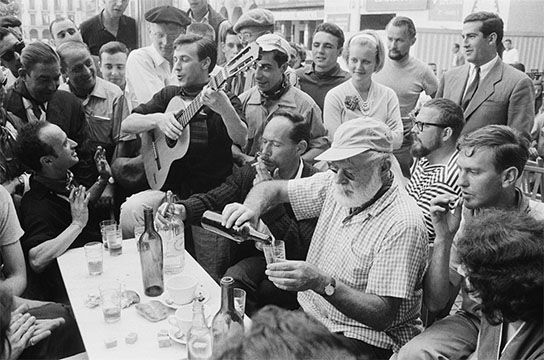Plaza del Castillo, Jul 1959. Hemingway’s last visit to Pamplona
42
Hemingway and the Cocktail
Ernest Hemingway (21 Jul 1899 – 2 July 1961) was, among other things, a war correspondant, bullfighting aficionado, American expatriate, novelist, cat-fancier, fisherman, sub-chaser, Pulitzer and Nobel Prize winner and, for our purposes here, a rather serious drinker. Ernest, or Papa, began drinking as a teenager in his cub reporter days and continued, unabated, throughout his life. Toward the end of his life he was reportedly drinking the equivalent of a quart of whiskey a day.
Over the years Hemingway drank pretty much anything and everything, and so did the characters of his novels. In fact it would be easily possible to write an entire bar tending guide just from the descriptions in his novels.1
This severely attenuated list includes recipes, as best as I can determine them, for some of his more famous cocktails:
Death in the Afternoon
This drink, named after Hemingway’s metaphysical treatise on bullfighting,2 was reportedly invented by Papa with “some Brits after a spot of nautical unpleasantness.” He contributed the recipe to a 1935 collection of celebrity recipes:
- 1½ oz. absinthe
- 4 oz. cold brut champagne
- Pour a jigger of absinthe into a champagne flute. Add iced champagne until it attains the proper opalescent milkiness (about 4–5 oz). Hemingway suggested drinking three to five of these slowly (and if you do, let me know how that turns out).
Death in the Gulf Stream
Charles Baker, in his 1939 classic The Gentleman’s Companion3 included this drink prepared for him by Papa during a Jan 1937 visit to the author in Key West. Hemingway described it as a “picker-upper” Baker writes: “It’s tartness and its bitterness are its chief charm.” In other words – a typical Hemingway cocktail.
- 2 oz. Lucas Bols Oude Genever
- 4 dashes Angostura
- 1 lime
- Add crushed ice to a thin tumbler. Lace the ice with 4 dashes of Angostura and add the juice and crushed peel of 1 lime. Nearly fill the tumbler with Genever.
Mojito
There is a letter, supposedly written by Hemingway, on the wall at La Bodeguita del Medio, that says “Mi mojito en La Bodeguita, mi daiquiri en El Floridita.” Experts, however, doubt that Hemingway was much of a mojito drinker (a drink too sweet for his tastes), and may have never set foot in La Bodeguita. Nevertheless, here is the classic La Bodeguita recipe:
- 2 oz. Havana Club Añejo Especial or Añejo Blanco rum
- 1 tsp. fine cane sugar
- 2 oz. squeezed lime juice
- 4 Yerba buena mint leaves 4
- 4–6 ice cubes, broken
- 2 oz. club soda
- Add the mint leaves, squeezed lime juice and sugar to a collins glass. Gently muddle the mint. Add the rum and the broken or crushed ice and stir. Top off with club soda. You can garnish with a mint sprig or a quartered lime wedge, knock yourself out, it dosen’t really matter since we have established this really isn’t a Hemingway drink.
The Montgomery
Hemingway ranked dry martini drinking somewhere between bullfighting and big-game hunting in his list of manly pursuits. Papa called this martini, which he drank at Harry’s Bar in Venice, the Montgomery, after Field Marshal Bernard Law Montgomery. The joke goes that Montgomery would not attack unless he had a 15:1 advantage in forces, which is what Papa thought the gin-to-vermouth ratio was in this drink. It reality it is closer to 10:1.
- 2 oz. Gordon’s gin
- 1 tsp. + a few drops Noilly Prat vermouth
- Olive
- Pour ingredients into an ice-filled shaker. Shake, then strain into a martini glass. Garnish with an olive.
Papa Doble
The El Flordita, under the legendary cantinero Constantino Ribalaigua Vert, became known as “La Catedral del Daiquiri.” The Papa Doble, Hemingways’s famous daiquiri, was essentially a double of the Flordita house drink, substituting Maraschino for sugar.
- 4 oz. Bacardi white-label rum
- ¼ oz. Luxardo Maraschino 5
- 2 limes, hand squeezed
- ½ grapefruit, hand squeezed
- Fill an electric blender one-quarter full of shaved or cracked ice. Add all of the ingredients and blend on high until the mixture turns cloudy and light-colored. Strain into a chilled collins glass. It was reported that Hemingway once drank 15 or 16 of these at one sitting, although that seems like alot of grapefruit juice, don’t you think? It should be noted that once strained, the drink resembles a sour, not a frozen daiquiri (although Hemingway drank as those as well).
n = 5
Cocktails with added sugar: n = 0
1. Which, of course, has been done more than once, consult Google books or Amazon. For something a little more scholarly see: Olihant, Ashley Y. “Hemingway’s Mixed Drinks: An Examination of the Varied Representation of Alcohol Across the Author’s Canon.” Diss. U of North Carolina at Greensboro, 2007. Here is the pdf.
2. Hemingway, Ernest. Death in the Afternoon. New York: Charles Scribner’s Sons, 1932.
3. Baker, Charles H. The Gentleman’s Companion (2 vol). New York: The Derrydale Press, 1939. If you have an original copy of this you have both my envy and congraulations.
4. Throughout Spanish-speaking Central America Yerba buena simply refers to the local species of mint. In Cuba this would be Mentha nemorosa Willd. (AKA foxtail mint, hairy mint, woolly mint, et. al.). which is rather sweet and citrus-like.
5. It should be noted that there is simply no substitute for the Maraschino (and best of luck in finding it).
1 Oct 2009, updated 28 May 2010 ‧ Lists & Tables
